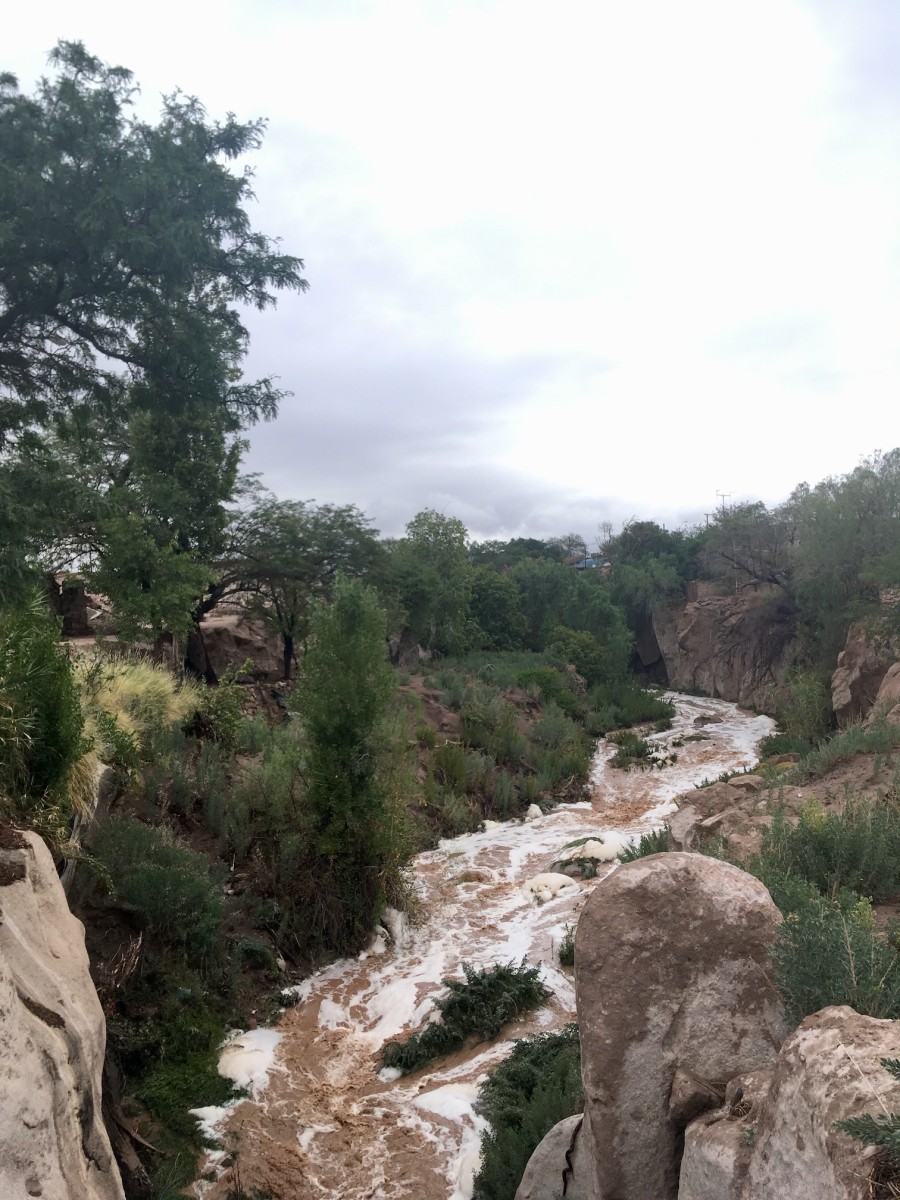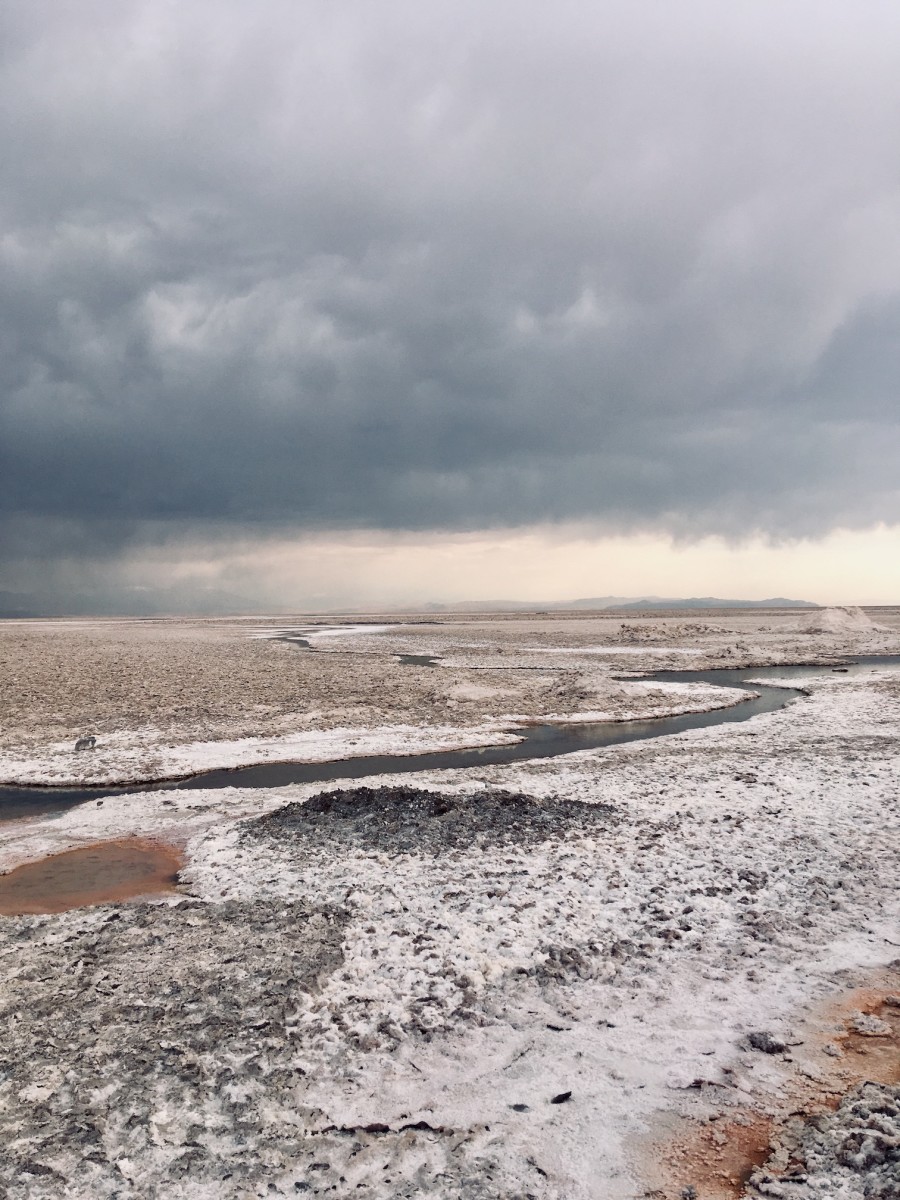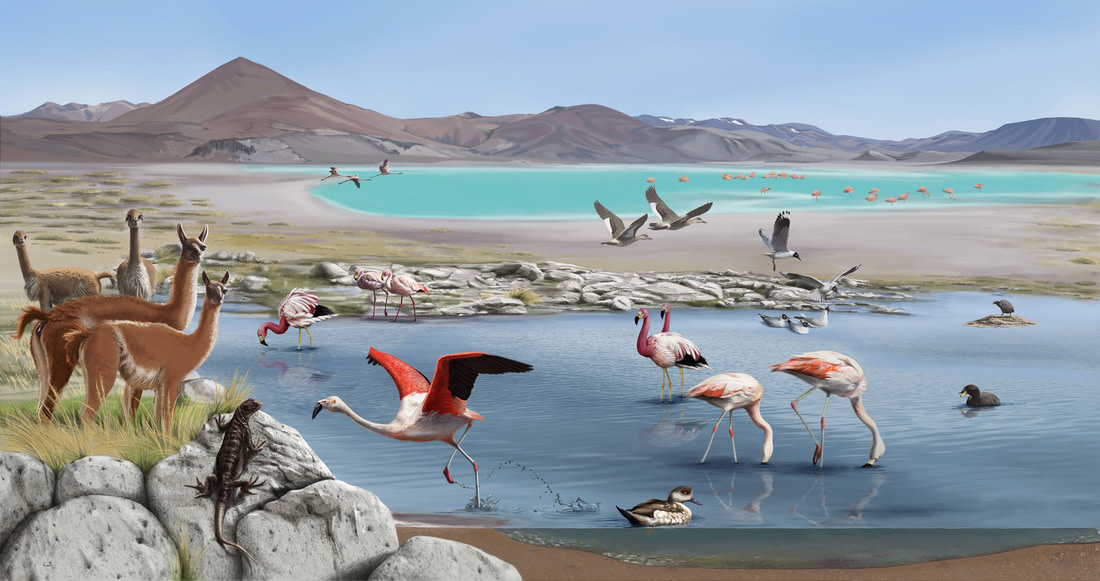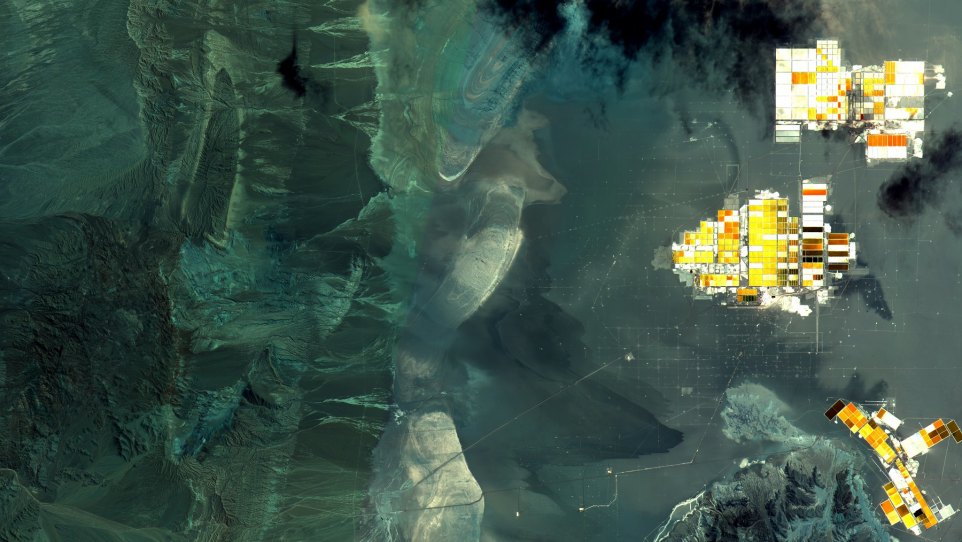Clean energy advocates envision an electrified home running on 100 percent renewable energy with a Tesla parked in its garage, solar shingles gleaming on its rooftop, and a smart meter dutifully collecting usage data and uploading it to the cloud. But swim upstream and eventually you arrive at the extractive frontiers of the renewable energy transition.
It was 8:45 am on the first day of the 11th Lithium Supply & Markets Conference in the basement level of the W Hotel in Santiago, Chile. There was no way for me to blend in. “Providence College” on my name tag rendered me a curiosity. Still, I was glad I remembered to wear lipstick and that my backpack had straps that converted it into a tote.
I found an empty seat in the sea of suits, almost all men but of different ages. They hailed variously from China, Australia, Chile, the United States, the United Kingdom, and Argentina. They were market analysts and prospectors; equipment salesmen and regulators; executives, consultants, and peddlers of information in the notoriously opaque world of lithium, a “space,” in Silicon Valley talk, not quite meriting the word “market.”
As I slid into my seat, the chairman of one of the largest lithium companies in the world, with a sordid past in a corrupt privatization process under Augusto Pinochet’s brutal dictatorship, took to the stage. “Mining is the spine of Chile; mining runs through our veins.” I might have been the only person in the room who immediately thought of Eduardo Galeano’s anti-colonial page-turner, Open Veins of Latin America — incidentally penned the same year Pinochet came to power, brutally crushing the dream of democratic socialism in Chile. But I don’t think the chairman meant to call to mind the vampiric iconography of global capital. The dead sapping the living; the blood and sweat and tortured landscapes of extraction, especially in its colonial variant.
Arm Wrestling in the Atacama
Lithium is the third element in the periodic table. It is highly reactive and exists either in compounds with other minerals in rock formations, or in clay deposits, or dissolved as an ion in brine. It is also the active ingredient in the lightweight rechargeable batteries that power electric vehicles (EVs) and store energy on renewable grids. This is why lithium is essential for the coming energy transition.
In the United States, transportation is the single largest source of carbon pollution, accounting for about 30 percent of emissions. Achieving anything like a safe climate means we have to swap internal combustion engine vehicles for EVs, and hook up those cars, trucks, and buses to an electric grid powered by wind or sun. (Transitioning from a model of individual cars to one of mass transit would facilitate this process, and have other positive environmental effects.) Lithium enters into this equation twice. First, it is a material input for EV batteries. Second, batteries are in effect an energy storage technology, and grids that operate on intermittent gusts of wind and rays of sun need a mechanism to smooth supply and match it to demand. (Dramatically reducing our overall energy consumption would also help.)
The brines of Chile’s Salar de Atacama lie 7,500 feet above sea level on an Andean plateau and supply roughly 30 percent of the world’s lithium. These salty underground reservoirs are located beneath a closed basin ringed by the Andean mountain range. A perfect storm of climate, geology, and chemistry has concentrated lithium in the waters below the rugged surface of the vast Atacama salt flat, which in total measures about two-thirds of the surface area of my home state of Rhode Island.
But resource extraction throws this vulnerable desert wetland out of whack. Getting the lithium entails sucking up the brine at an astounding rate. SQM, the company whose chairman I heard at the conference, pumps out brine at a rate of 1,700 liters a second — 95 percent of which is then evaporated. In other words, extracting lithium involves drawing up a lot of water and throwing most of it into the air.
Almost any corporate representative will say that extracting and evaporating brine has no effect on freshwater. But talk to any scientist or regulator familiar with the Atacama basin and they will tell you that the two types of water interact — that removing the brine eventually lowers the water table, threatening supplies needed for drinking and irrigation.
You can think about it like an arm-wrestling match. The brine water is underneath the salt flat. The freshwater systems are located at the flat’s perimeter. The two kinds of water are separated by a dynamic interface: a surface tension generated by the fluid’s differing density levels. Brine is much denser than freshwater, weighed down by dissolved elements like lithium. But while brine has the force of mass on its side, freshwater — which originates from snowmelt high up in the Andean peaks and the aquifers they feed — has the force of gravity in its favor. They are locked in a contest: mass versus gravity. When brine is removed, the interface separating them shifts towards the center of the salt flat, dragging freshwater with it — and away from the Indigenous communities located on the flat’s perimeter.
Flamingos and Quince
I first saw the Salar de Atacama after driving around the mountains on the border of Bolivia. The Licancabur volcano loomed over us. We drove through a sandstorm, my first — memorable for its force, noise, and the way the suspended sand revealed the dance of the air’s rapid movement — which was made stranger by being paired with a rainstorm. We drove through many microclimates. The vegetation completely changed with the elevation. Gaining in altitude, the cooler and wetter air supported denser life; scrubby patches gave way to lusher meadows.

Descending again, we entered the desert. Oases dotted the landscape: trees and shrubs congregated around the streams that flowed through mountain ravines. These quebradas are the basis of the built environment and social life of the eighteen Indigenous communities that neighbor the salt flat. Traveling through stone canals and filters, the quebradas feed small farms. The plots are enclosed with rustic wood fences and strategically planted trees for shade. They produce an incredible variety of produce. On a visit to the community of Toconao, I spotted figs, pomegranates, and quince along with the usual maize.

Driving further east, we reached the Los Flamencos National Reserve: an immense sweep of white and grey, rimmed by mountains in all directions. To our left was pure salt crust; to our right was the same crust interspersed with lagoons, where flamingos fed on tiny brine shrimp. The lagoons were tinted red in places, from the interaction of algae, sun, and wind. It was expansive in a way I associate with the ocean. The ground was crunchy and knobby beneath my hiking boots.

Just out of view were the zones of extraction. Thirty kilometers away, swallowed by the horizon, stood the big lithium installations. During the conference in Santiago, I had heard executives say that environmental protection measures should be improved — but also that there was nothing to be worried about. The rich ecosystem of these desert wetlands — the cotton-candy-pink Andean flamingos, white tufted grebes, and regal vicuña — did not figure prominently in the discussion. Indigenous communities were briefly invoked, and workers got a mention or two. But for most of the conference, the human and ecological texture of the salar receded from view.

Yet communities like Toconao are already feeling the effects of extraction on their everyday lives. Abnormally arid conditions reduce the streams’ flow, constraining access to water for crops and drinking. And, due to global warming, the swings are getting more unpredictable: long dry spells are punctuated by mega-rains that destroy infrastructure and plants, and can’t easily be absorbed by the soil. These changes also threaten habitats for wild vegetation and animals: biologists have found reduced species counts for the Andean flamingos.
For the suits at the W Hotel, the Atacama was an extraction site, an operational landscape, the beginning of a long trail of logistics and profit. But what of the vicuña and the quince, and the communities rooted in the flow of the desert’s precious water? What would it look like to bring these into view?
Teeming, Crawling, Floating, and Flying
The day after my first visit to the salt flat, I met Ramón. We spoke for three hours, neglecting other appointments, over coffee and medialunas de manjar de leche, which are croissants filled with caramel made from condensed milk.
In contrast to many of the petit-bourgeois transplants in San Pedro, the mushrooming tourist hub in the Atacama, Ramón is from a working-class family on the rural outskirts of Santiago. He is a cofounder of the Plurinational Observatory of Andean Salt Flats (el Observatorio Plurinacional De Salares Andinos), a transnational network of environmentalists, concerned scientists, activist lawyers, and residents of affected Indigenous and campesino communities from across the Andean plateau known as the “lithium triangle.” The lithium triangle encompasses parts of Argentina, Bolivia, and Chile, and contains more than half of the world’s known lithium reserves — although members of the Observatory dislike the term for reducing their world to the resource extracted from it. (Full disclosure: I am a member.)
The Observatory pushes back against “green extractivism”: the subordination of human rights and ecosystems to endless extraction in the name of “solving” climate change. Its platform affirms the broader cultural, natural, and scientific value of the salt flats — not just the economic value of its lithium.
It’s challenging work. The Observatory is trying to weave together a novel organizational form, with ambitions at the transnational scale of extractive capital. But organizing across three national borders, in rural spaces crosscut by dirt roads and underserved by transit and WiFi, is hard. At the industry conference in Santiago, there were tensions between capitalists and the state, and between potential investors and mining firms. But on the whole, these elite alliances are relatively easy: lubricated by money and airplanes, smartphones and endless hors d’oeuvres. The obstacles facing international movement-building are much larger.
These obstacles were in evidence at an Observatory gathering at the University of Atacama in June 2019. The Argentinian delegation never made it: snow had rendered the border crossing impassable. The president of the association of eighteen Indigenous Atacameño communities, Sergio Cubillos, was likewise absent. The communities he represents, along with Indigenous groups throughout the country, were engaged in an all-out mobilization against Chilean President Sebastián Piñera, whose government was trying to further fragment and privatize Indigenous territory.
But those who made it to the gathering were able to help develop a different vision for the habitats and wetlands of the region — an alternative to the one being pursued by the suits in Santiago. This vision is vividly captured in the work of Portuguese artist Mafalda Paiva, which were displayed at the Observatory event. In her paintings, the salt flats hum with a preternatural vibrancy, an effect produced by the exaggerated density of species and radically foreshortened topography. This teeming, crawling, floating, and flying life was invisible at the Santiago conference but composed the emotional core of the Observatory gathering. Paiva offers a kind of eco-utopian hyperrealism — and orients us to a very different future than that imagined by lithium capitalists.

Common Futures
The Observatory opposes green extractivism because of the very real harm it inflicts on humans, animals, and ecosystems. But their position raises thorny questions about the renewable energy transition. As each dire climate science report makes clear, emissions from fossil fuels are rendering the planet increasingly unlivable. At the same time, building a low-carbon world carries its own environmental and social costs: every wind turbine, solar panel, and electric vehicle requires vast quantities of materials mined from the earth, transported in container ships over great distances, manufactured in factories likely still powered by coal, and transported again to consumers. This globally dispersed supply chain, like any other under capitalism, facilitates a race to the bottom, as capital perpetually seeks cheaper labor and cheaper nature.
Not all communities along this chain have a say in who bears the social and environmental costs, or how much effort should be expended to reduce them — unless they force the matter. The vaster and more complex the chain, the more challenging it is to mobilize across it. This global spread isn’t new: the Industrial Revolution was enabled by raw materials extracted and harvested far from industrial centers. But in recent decades, technologies that disperse production even further have proliferated, from container ships to new trade agreements, computer-enabled “just-in-time” manufacturing to Special Economic Zones, making global capitalism an infinitely more intricate and interdependent web than Adam Smith ever dreamed.
When it comes to the renewable energy transition, how this web works has especially high stakes. It is a question of who controls our future. A world buzzing with hundreds of millions of Teslas (or worse, e-Escalades), made with materials rapaciously extracted without the consent of local communities, manufactured under a repressive labor regime in polluting factories — in other words, a world not unlike our own, but powered by wind and sun — is not an inevitability.
Other futures are also possible. The already unfolding energy transition offers a historic opportunity to dismantle the American lifestyle of privatized and segregated suburban affluence and build something better in its place. This lifestyle has always been a nightmare, ecologically and politically. The less energy we consume, the fewer raw materials we will need. This is not a call for eco-austerity: currently, energy consumption is highly unequal and wasteful. We can construct a society that is both low-carbon and plentiful in the ways that matter for most of us.
Doing so will require acknowledging how the material substrate of our lives is intimately, and often violently, connected to ecosystems and people beyond our borders. Trade, production, and consumption could, in theory, be reorganized to prioritize climate safety, socio-economic equality, Indigenous rights, and the integrity of habitats.
Yet achieving such an outcome will take political power, strategically deployed. Amid the overwhelming complexity of contemporary capitalism, it’s easy to forget that supply chains are not the product of geographic destiny. Indeed, a key aspect of environmental injustice is that contaminating processes — mines, power plants, or factories — are sited where ecosystems and human lives are seen as disposable or deemed to lack political influence.
The corollary is that force from below can obstruct and even reshape global flows. This force is particularly effective when exercised at “chokepoints”: points of obligatory passage for people and goods. In addition to the factory floor itself, the infrastructure of logistics (ports, ships, warehouses) and the sites of extraction (mines, rigs, refineries) are potential bottlenecks, and thus nodes of vulnerability for the system as a whole. In other words, they are strategic sites for disruption.
I might not know the exact shape of the world I want. The present weighs heavily and makes imagination difficult. But I know it starts with relating to this planet’s bounty as mysterious, vital, and nourishing; envisioning abundance as shared flourishing; and broadening our solidarities to encompass people we may never meet and places we may never visit but whose futures are bound up with our own. The salar will thank us.
